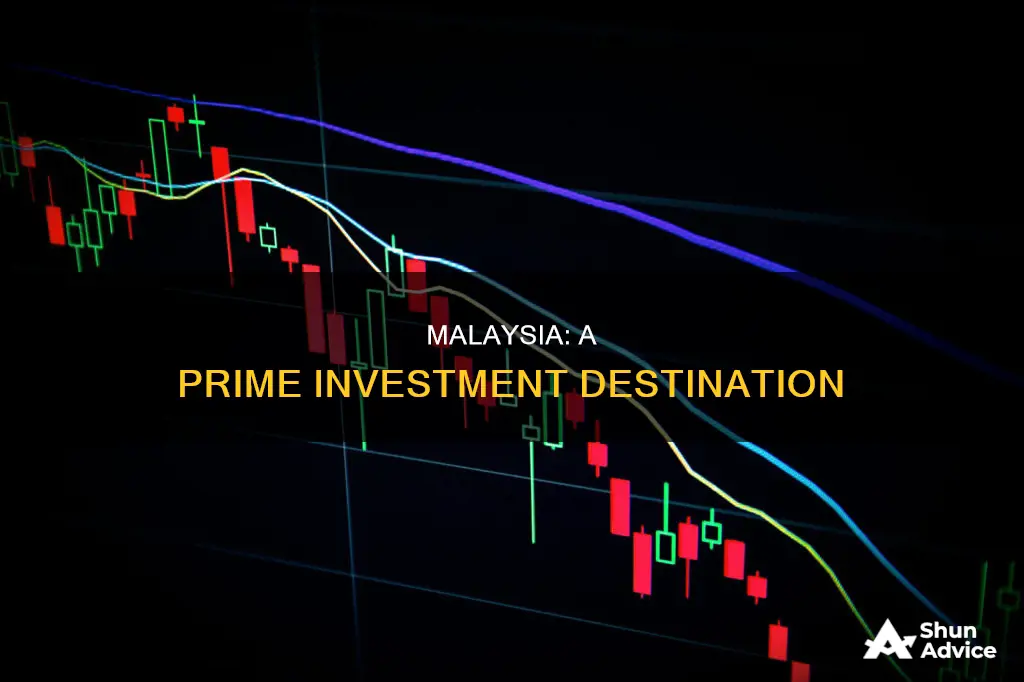
Malaysia has long been an attractive destination for foreign investment, particularly from the United States. In 2022, the US was the biggest source of foreign direct investment into the country, amounting to $13.2 billion. This is due to a variety of factors, including Malaysia's stable and well-developed economy, its implementation of policies and incentives to attract foreign investment, its high-quality infrastructure, its population's relatively high level of English proficiency, and its geostrategic location.
Foreign direct investments (FDI) have been a mainstay of Malaysia's economic development and politics since the 1980s, when Mahathir Mohamad initiated an aggressive industrialization plan to attract overseas investment. FDI has contributed to job creation and technology transfer in Malaysia. However, there have been concerns about the country's ability to follow through on investment pledges, with analysts urging the government to establish a monitoring system to ensure proposed investments are realized.
| Characteristics | Values |
|---|---|
| Economic development | FDI contributed to 5% of Malaysia's GDP in 2021 |
| Economic growth | FDI was a key driver of Malaysia's explosive growth in the 1980s and 1990s |
| Job creation | FDI creates jobs for locals |
| Technology transfer | FDI allows technology transfer to local companies |
| Political policy | FDI is used as a political tool to gain support |
| Investment incentives | Tax incentives, special economic zones, and investment-friendly regulations |
| Infrastructure | High-quality infrastructure with substantial investments in connectivity, transportation, and logistics |
| English proficiency | High level of English proficiency among the population |
| Geostrategic location | Access to regional markets and international shipping routes |
What You'll Learn

Malaysia's strategic location and access to Southeast Asian markets
Malaysia's proximity to major Asian markets and its integration with the global economy provide a strategic advantage for businesses looking to expand in the region. The country has a strong economic performance and is firmly integrated with the global economy, making it attractive to foreign investors.
The country's ICT infrastructure is highly developed, with mobile penetration rates exceeding 100%. This enables businesses to stay connected, utilise digital tools, and access global markets and suppliers easily. Additionally, Malaysia has a large pool of skilled workers, making it easier for companies to find the right talent.
Malaysia's manufacturing sector is particularly well-suited for investment due to its strong government support, favourable location, competitive costs, and skilled workforce. The sector contributes significantly to the country's GDP and employment, with strong clusters in electrical and electronics, petrochemicals, machinery, food and beverages, and textile and apparel.
The country's services sector is the second-largest contributor to foreign direct investment (FDI), followed by the mining sector. Malaysia's FDI inflows have been increasing, with the total stock of FDI reaching USD 199.2 billion in 2022. The country's investment landscape is further strengthened by its strategic positioning and connectivity, making it an ideal place for businesses to expand and access Southeast Asian markets.
Equity-Based Compensation: Investing, Operating, or Financing?
You may want to see also

Abundant land and natural resources
Malaysia's abundance of land and natural resources is a key factor in attracting foreign investment. The country has a wide array of natural resources, including fertile land for agriculture, extensive forests, and valuable mineral deposits.
Malaysia's fertile agricultural land supports a thriving agricultural sector, which accounts for around 12% of the country's GDP and employs about 16% of its population. The country is a leading exporter of agricultural products such as palm oil, timber, cocoa, pineapples, and rubber. In recent years, there has been a shift towards palm oil production due to its higher profitability compared to rubber.
In addition to its agricultural resources, Malaysia is also rich in mineral resources. The country has extensive mining sites for gold, copper, tin, silica sand, bauxite, and limestone. While tin mining declined in the early 1980s due to market competition and declining prices, Malaysia was once a global leader in tin production, accounting for around 31% of global tin output. Gold is primarily mined in areas like Penjom, Selinsing, and Raub, with minor deposits found in other regions. Iron ore mining is also significant, with 98 mines located mainly in Johor and Kedah, producing around 10 million tons of iron ore in 2012.
Forestry is another vital component of Malaysia's natural resources. The country boasts a massive forest coverage of approximately 22.2 million hectares, with natural forests accounting for about 20 million hectares. Timber is a significant export commodity, and in 2015, the forestry sector generated revenue of around $2.5 billion through the export of logs.
Moreover, Malaysia's natural resources include valuable petroleum reserves, which are the country's most economically important resource. As of 2014, Malaysia's oil reserves were estimated at 4 billion barrels, ranking fourth in the Asia-Pacific region. The country's natural gas deposits are also substantial, with an estimated 83 trillion cubic feet of natural gas reserves. Most of the oil and gas fields are located offshore, and the revenue generated from these resources accounts for a significant portion of the country's export earnings.
The abundance of land and natural resources in Malaysia provides a solid foundation for economic growth and attracts foreign investment by offering diverse opportunities in agriculture, mining, forestry, and the energy sector.
Grass-Fed Beef Equity: A Smart Investment Strategy
You may want to see also

Highly developed information and communications technology (ICT) infrastructure
Malaysia has a highly developed information and communications technology (ICT) infrastructure. The country's ICT industry has seen strong growth since the pandemic, contributing 23.2% to Malaysia's GDP in 2021 and projected to rise to 25.5% by 2025. The government has embraced a country-wide digital transformation, recognising the importance of digitalization for securing Malaysia's role in the future global economy.
The Malaysian government launched the MyDIGITAL initiative as part of the Malaysia Economy Digital Economy Blueprint, aiming to transform the country into a digitally driven, high-income nation and a regional leader in the digital economy by 2030. This initiative includes the Cloud First strategy, which seeks to enhance Malaysia's capabilities as a regional data hub and attract investment in data centres.
Malaysia has also prioritised cybersecurity by launching the Malaysia Cyber Security Strategy (MCSS) with an allocation of $434 million to strengthen national cybersecurity. The government is working towards establishing a national Cybersecurity Commission and amending laws to protect personal data.
The country is also integrating emerging digital technologies, such as AI, the Internet of Things (IoT), Big Data Analytics (BDA), cloud computing, robotic process automation, virtual reality, digital payment, 5G, and blockchain. The government is offering incentives, including tax breaks and a $4.6 billion Industry Digitalization Transformation Fund, to encourage the adoption of these digital technologies.
Another significant opportunity is the development of Smart Cities, which incorporate ICT, healthcare, energy, environment, transportation, and infrastructure. Malaysia's investment in its ICT infrastructure has made it an attractive destination for foreign investment, with its digital economy supported by a skilled, English-speaking workforce and a robust ecosystem of manufacturers and suppliers.
Smart Guide to Making Investments in India
You may want to see also

Skilled, English-speaking workforce
Malaysia's workforce is a key factor in its attractiveness to foreign investors. The country's workers are skilled, proficient in English, and benefit from a robust ecosystem of manufacturers and suppliers across key sectors.
Malaysia's workforce is highly skilled, with a particular emphasis on the manufacturing sector. The country's manufacturing industry is highly diversified, with strong clusters in electrical and electronics, petrochemicals, machinery and equipment, food and beverages, and textile and apparel. Over 2 million people are employed in the manufacturing industry, contributing to about 27% of the country's GDP. The government has been supportive of the development of the manufacturing sector, with various initiatives and policies introduced to promote investment and growth.
In addition to their manufacturing prowess, Malaysia's workers are also proficient in English. This makes it easier for foreign investors to communicate and collaborate with the local workforce.
Malaysia's robust ecosystem of manufacturers and suppliers across key sectors, including medical devices, semiconductors, and solar panels, further enhances the country's investment climate. This ecosystem is supported by a highly developed information and communications technology (ICT) infrastructure, which facilitates the growth of these key sectors.
The combination of a skilled, English-speaking workforce and a robust manufacturing ecosystem makes Malaysia a highly attractive destination for foreign investment.
Retirement Investments: Best Places for Your Savings
You may want to see also

Robust ecosystem of manufacturers and suppliers across key sectors
Malaysia has a robust ecosystem of manufacturers and suppliers across key sectors, including medical devices, semiconductors, and solar panels. This ecosystem is supported by the country's strategic location and access to Southeast Asian markets, its abundance of land and natural resources, and its highly developed information and communications technology (ICT) infrastructure.
The country's manufacturing sector, which accounts for over 40% of its GDP, is a significant contributor to its economic growth and has been a focus of foreign investment. In 2022, Malaysia's manufacturing sector attracted MYR 17.1 billion in foreign direct investment (FDI), resulting in a net inflow of MYR 49.5 billion.
Malaysia's electrical and electronics (E&E) industry is a key driver of the country's exports and employment. The industry produces 13% of global back-end semiconductors and contributes about 5.8% to the country's GDP. Malaysia benefits from the global demand for mobile devices, storage devices, optoelectronics, and embedded technology.
The country is also a major hub for solar equipment manufacturing, with factories of companies like First Solar, Panasonic, and SunPower. In 2014, Malaysia was the world's third-largest manufacturer of photovoltaics equipment.
Malaysia's automotive industry is the third-largest in Southeast Asia and the 23rd largest in the world, with an annual production output of over 500,000 vehicles. The industry contributes RM40 billion to Malaysia's GDP and employs over 700,000 people.
The country's construction industry is also significant, valued at over RM102.2 billion (US$32 billion). The expansion of this industry has been catalysed by major capital expenditure projects and public-private partnership (PPP) mega-projects.
Malaysia's robust ecosystem of manufacturers and suppliers is further strengthened by its skilled, English-speaking workforce and the government's commitment to attracting foreign investment through various incentives and policies.
Portfolio Variance: Impact of 20% Investment Strategy
You may want to see also
Frequently asked questions
Malaysia has a strong and diversified economy, with a strategic location and access to Southeast Asian markets. It offers abundant land and natural resources, a highly developed information and communications technology (ICT) infrastructure, and a skilled, English-speaking workforce. The country has a robust ecosystem of manufacturers and suppliers across key sectors, including medical devices, semiconductors, and solar panels. Malaysia's commitment to sustainability, with initiatives such as the National Energy Transition Roadmap, and its position as a leading hub for Islamic finance also make it an attractive investment destination.
Malaysia has a stable and conducive environment for long-term capital appreciation. It offers a wide range of investment opportunities, including equities, bonds, and derivatives. The country has a low-risk investment environment with strong economic fundamentals, including steady GDP growth, a continuous current account surplus, and a commitment to sound fiscal and monetary policy. Malaysia also provides incentives such as tax breaks and income tax exemptions to encourage foreign investment.
Investing solely in Malaysia can expose investors to country-specific risks, including political, event, and economic risks. For example, in 2015, the Malaysian stock market suffered due to publicised political scandals and depressed global commodity prices. Additionally, investors with a "home bias" may limit their investment opportunities and miss out on long-term returns from other economies.
Malaysia has a diverse range of sectors that are attractive for foreign investment. Key sectors include services such as finance, tourism, and information technology, which contribute significantly to the country's GDP. Additionally, the manufacturing sector, particularly in electronics, textiles, and palm oil, has been a major driver of economic growth. The country also has a strong Islamic financial sector and is a global hub for Islamic finance.







